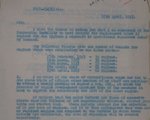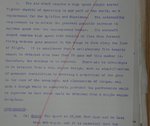fastmongrel
1st Sergeant
Another Photo;

Note group of men standing next to wing root. In the diagram in the previous post the 3 areas in the leading edge of the wing with large Xs may have been fuel tanks. Granted they seem to have shifted to a more elliptical shaped wing but depending on spars going through fuselage the bomb bay in the fuselage may have been rather restricted in size.
Thats a very thick wing, looks to be around 7 feet it would have taken a lot of power to get to the claimed 360mph and 30,000ft max altitude



